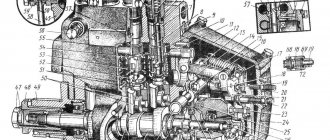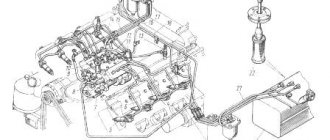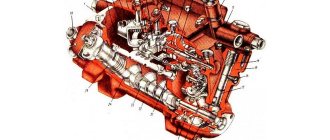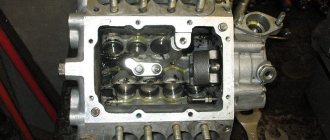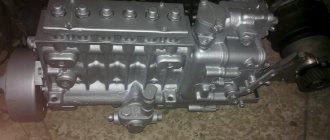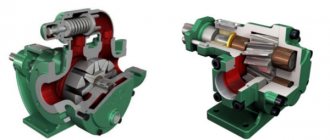Malfunctions of diesel injection pumps lead to loss of power, increased fuel consumption, difficult starting, increased exhaust smoke, and others. Typical breakdowns of a high-pressure fuel pump in a diesel car include water getting into the plunger pairs, a drop in pressure in the plunger pair, damage to the integrity of the sealing rings, sensor or wiring malfunctions (in electronically controlled diesel engines). Ideally, the injection pump should be checked at a special stand in a car service center, but simple checks of the fuel pump can be done in a garage.
Types of fuel pumps
First, let's look at the types of fuel pumps for diesel cars, since each of them has its own characteristics and typical fuel injection pump malfunctions. So, knowing what type of pump it is, you can better understand the principle of operation and the immediate cause of the breakdown. Regardless of the type of high-pressure pump, you need to understand that the main unit is the so-called plunger pair - a piston (plunger) and a cylinder (bushing).
There are two main types of injection pumps:
- with direct action and mechanical action of the plunger;
- with battery injection.
However, high-pressure fuel pumps are still divided into classes according to their design. In particular:
- Rows . As the name implies, their working sections are arranged in one row, and fuel is supplied to each cylinder in turn.
- Distribution . With such pumps, one section can supply fuel to several different cylinders. Such devices can be single- or double-plunger.
- Multi-sectional . Another name for them is V-shaped or hydraulic accumulators. They are used for highly powerful, but low-speed engines. They are quite rare.
With direct injection fuel pumps, pumping and injection occur simultaneously. The mechanical drive of the plunger is responsible for this. With battery pumps, fuel is supplied in separate cycles, first it enters the pump accumulator, and only then into the injectors. The most modern systems are controlled electronically and are called Common Rail. They work based on information from numerous sensors located in different parts of the car.
Another injection system is a pump injector. In this case, they are combined into one mechanism. This system simplifies pressure control and also increases reliability, because if one injector fails, the engine will continue to operate, albeit with less power.
High-pressure fuel pumps were also invented for gasoline engines. They are used in engines with direct fuel injection. The pump's job is to supply gasoline under high pressure into the cylinders, where the fuel is directly mixed with the air mass, forming a mixture that is ignited by the spark plug.
Signs of fuel injection pump malfunction
Despite the fact that high-pressure pumps belong to different types, the signs of their partial failure are typical and in many ways common to all. So, symptoms of a fuel injection pump malfunction include:
- increased fuel consumption in all engine operating modes;
- unstable operation of the engine, especially at low speeds;
- difficulty starting the engine, most often in the cold season;
- drop in engine power and dynamic characteristics of the machine as a whole;
- increase in engine exhaust smoke;
- fuel leak from the high pressure pump;
- the appearance of an oil emulsion in the engine coolant;
- increased engine noise.
Please note that the symptoms listed above may be signs of failure of other parts of the car's engine, such as the cooling system. Therefore, the condition of the high pressure pump must be diagnosed separately.
Experienced car enthusiasts identify another sign of a faulty high-pressure pump plunger. It lies in the fact that when the engine is hot, it may stall when idling. And at the same time, it will be almost impossible to start it until the pump itself cools down. “When cold,” the engine starts without problems.
740.90-1111005-10 Injection pump drive gearbox for KamAZ-6522 (Euro-4)
There are situations when the plates break while traveling outside the city. But how to be and what to do, we will consider the details further.
The moment of injection is the meaning of the process
The injection moment is the beginning of the fuel supply at the moment when the valve is at its maximum highest point with the intake and exhaust pistons closed. As a result, the piston compressed the air as much as possible, which means fuel can be supplied.
Adjustment of this process is necessary for the following reasons.
- This period is different for each power unit.
- Differences in fuel, for example, winter and summer diesel fuel.
For ease of adjustment, each engine has corresponding marks and degrees. If you set the injection timing strictly according to the specified values, then KamAZ will behave properly, provided that it has a calibrated engine, a high-pressure fuel pump and GOST fuel.
How to install a fuel injection pump on a KamAZ? The drive is installed on a key on the gearbox side. The coupling can be rotated in two directions by 180 degrees. If the drive clamp screw is located in the upper part, then the mark on the pump and coupling should be opposite each other.
Having installed everything as expected, you can start the engine. If it happens that the engine activation is not completed, and thick white smoke is pouring out of the exhaust pipe, then this means that they have been mixed up by 180 degrees. The problem can be solved by turning the coupling in the other direction.
Reference! If it turns out that there are several marks on the coupling, then it is recommended to place it approximately in the middle of the adjustment slots.
Signs of injection
There are two points of incorrectly adjusted injection:
- late;
- early.
Since there can be two incorrect settings, each of them has its own symptoms. It is important to correctly distinguish between the symptoms indicating these failures.
Late injection
This is a situation in which the check valve of the KamAZ 740 fuel injection pump is already lowering from the maximum upper point, and the fuel is just starting to flow, and an explosion follows.
In the functioning of the power unit, this is shown by several signs.
- White exhaust gases, especially when the engine is cold.
- The number of revolutions increases.
- It works smoothly.
- Quiet pressing of the gas pedal is accompanied by shaking of the engine at medium speeds. Afterwards it seems to break through, and the shaking disappears at elevated levels.
- KamAZ doesn't pull well.
- Increased fuel consumption.
- Overheat.
Early injection
A situation in which the piston has not reached its maximum point, but the combustible mixture is already entering, the explosion is directed towards the piston. The following signs indicate a problem:
- hard operation of the motor;
- with a sudden change of gas and increased load, a ringing is noted, and with increasing temperature the sound intensifies;
- if the injection occurs too early, white smoke is observed from the exhaust pipe;
- weak traction;
- increased fuel consumption.
Reference! The torque set at the factory is usually a little late.
Adjusting fuel injection pump KamAZ Euro 2
EURO-2 KamAZ- 6360-06, 6460-06, 5360-06, 5460-06
Technical characteristics of fuel injection pump 337-40, 337-70 engine
The injection pump 337-40 KAMAZ 740 is a high-pressure fuel pump, which is equipped with sections with a V-shaped arrangement and has a distance between sections of 36 mm. The fuel injection pump 337-40 is equipped with a regulator with two modes, as well as a direct and reverse corrector. Produced since 1995.
Number of fuel injection pump sections
Diameter/maximum stroke of plunger (mm)
N nom. (hp) at n (min -1)
Where is the injection pump 337-40 used?
EURO-1 KamAZ-55111-02, 65115, 53212-02,54112-02, 54115, 53215, 53205-02, 53213,53202, 53229-02, 54105-02, 53228-02, 4326,
Rules 96 Combine “Don-1500”
Rules 96 Tractors T-150K, HTZ-170, IFA feed chopper
Buses: NefAZ-5297, PAZ-5272, LiAZ-5256
Technical characteristics of fuel injection pump 337-42 engine
The injection pump 337-42 is a high-pressure fuel pump, which is equipped with sections with a V-shaped arrangement and has a distance between sections of 36 mm. The injection pump 337-42 is equipped with a mechanical all-mode regulator, as well as a direct and reverse corrector. Produced since 2002.
Basic rules for installing injection
There are several rules for setting injection timing that should be followed.
- It is preferable to start manipulations at the operating temperature of the motor. However, if the symptoms are obvious, then you can start working in cold weather.
- We install the drive so that the mark is on top, then lower the two bolts by 17 degrees.
- If the injection is early, then move the pump drive in the direction of travel or clockwise.
- If the injection is late, then vice versa.
- You need to move the drive a little at a time and constantly tighten the bolts.
Components
The correct operation of each component affects the operation of the pump as a whole. Breakage or excessive wear of any of them leads to disruption of the entire system. This is what the injection pump of a KamAZ truck consists of:
- pump section housing;
- cover body;
- booster pump;
- plunger pair;
- pusher;
- springs;
- mode regulator;
- fuel injection regulator;
- drain fitting;
- injection port;
- injection regulator;
- pressure reducing valve;
- fuel shutoff solenoid valve;
- rail.
The main causes of fuel injection pump malfunction
The following are the causes of high pressure pump failure. Typically, the following structural elements fail:
- Plungers . Most often they are to blame, since the plunger pairs quickly become dirty. This is due to two reasons. The first is design features that provide a small gap that ensures high pressure in the system. The second is the low quality of diesel fuel, in particular, the presence of sulfur and paraffins in it, which, in fact, pollute the device. Dirt can also come from the engine (carbon deposits, dirt). Wear of the plungers leads to unstable engine operation at idle, increased fuel consumption, and decreased compression. Due to damage to the plunger pair, the bearings can significantly overheat.
- Water in diesel fuel . Also, domestic diesel fuel often has a high water content. Moisture washes away the fuel (at the same time protective) film from the surfaces of fuel injection pump parts, which causes the service life of precision parts to be significantly reduced. This may even cause the pump to jam.
- Dirty fuel filter . Due to a clogged fuel filter, the high-pressure pump, firstly, can become dirty (plunger pairs), and secondly, it wears out, which reduces its overall service life.
- Uneven supply and distribution of injected diesel fuel . This problem can also be caused by a malfunction of the plunger pairs, in particular, wear of the drivers, rack teeth, discharge valves, as well as dirty nozzles.
- Manufacturing defect . This situation is quite rare, but sometimes occurs on cheap pumps. Defects include cracks on the fuel injection pump housing, damage to its bearings, as well as jamming of the plunger bushing.
- Bearing wear . They usually wear out due to a critical decrease in service life (aging). Another option is a manufacturing defect. All this leads to the fact that the operating characteristics of the pump deteriorate, and the bearings and adjacent parts overheat, thereby reducing their service life.
- Piston and bushing jamming . This is a critical failure that can lead to breakage of the rack, cam shaft, gear, governor, keys. Often the cause of jamming is water getting into the cavity between the piston and the bushing.
- Wear of pump parts . This can occur both for natural reasons (with an increase in the mileage of the car) and when water gets inside it. It washes away the protective (working) lubricant from the elements, which significantly reduces both the service life of the pump as a whole and its individual parts.
- Corrosion of the plunger pair . Rusting spots may appear due to the increased water content in diesel fuel.
- Incorrect operation of the cooling system . That is, under prolonged and/or heavy loads, the high-pressure pump may simply overheat. The cooling system can be faulty for various reasons - low level of antifreeze or antifreeze, system clogging, breakdown of individual elements (pump, pipes, radiator, etc.).
- Depressurization of the system . This can happen not only if the high-pressure pump seals are damaged, but also other sealing elements. In any case, if the fuel injection pump becomes depressurized, it will operate under increased load, which will not only reduce its service life, but will also lead to the described breakdowns.
- Incorrect operation of the injection advance valve . This unit is installed on modern Common Rail diesel systems in order to increase engine efficiency and reduce fuel consumption. In turn, said advance valve is controlled by a corresponding solenoid valve of the high pressure pump. The system is controlled by the ECU, which commands a plunger that opens the valve mechanism. This way the pressure in the system is regulated.
- Broken plunger return spring . If the spring breaks in one place, then this will be a partial failure, and the section will operate, but with low efficiency. If the spring breaks in several places, then most likely the section will fail completely. In some cases, there is a decrease in the spring stiffness of the discharge valve. In this case, it is advisable to replace it.
If there is a suspicion that the fuel pump rack or associated parts are faulty, then you need to check for the presence/absence of the following defects:
- disconnecting the rack from the regulator parts;
- jamming or loosening of the clamps of the plunger leads;
- jamming of the coupling screws of the gear rims.
One of the most dangerous causes of a malfunction is a violation of the mobility of the fuel rail. In particular, if it jams at the moment of maximum fuel supply, and accordingly, the regulator does not have enough force to shift it to its original position, then an emergency increase in the number of crankshaft revolutions occurs in the engine, due to which the engine “goes into overdrive” all the ensuing consequences. If the rack is “bitten” while the gear is off, then in this case it will be impossible to start the engine at all. Partial jamming of the rack leads to unstable operation of the engine and an increase in its sound output (it begins to “growl”).
When using the machine in severe frost conditions, freezing of individual parts of the pump is sometimes observed, and its partial failure. To prevent this, it is necessary to use oils and diesel fuel with appropriate temperature ratings.
On common rail diesel systems, the control valve (or SCV flow valve) can fail. Usually it is replaced with a new one. Less often, they perform an audit and replace individual parts with new ones. In particular, the valve stem and core are often replaced.
Operating rules
In order to minimize the risk of malfunction of the KamAZ fuel injection pump, you must carefully follow several fairly simple recommendations. These include the following rules for operating a cargo vehicle:
1. Use of exclusively high-quality diesel fuel. To do this, you should refuel at proven gas stations.
2. Regular cleaning and, if necessary, replacement of filters installed in the fuel supply system.
3. Regular cleaning and flushing of individual components and parts of the fuel supply system.
4. Use only certified additives and fuel additives after consultation with a specialist.
5. Contact a specialized service center if any problems arise in the operation of the injection pump and KamAZ diesel engine.
6. Regular service and maintenance of both the fuel supply system and the power unit as a whole.
7. Constant monitoring of the tightness of the fuel system of the truck and prompt elimination of detected leaks.
8. Constantly checking the reliability of fastening the injection pump to the diesel engine. If necessary, tighten loose bolted connections.
How to determine fuel injection pump malfunctions
Please note that it is best to test the high pressure pump on professional stands specifically designed for this purpose. They allow you to find out the operating characteristics of the pump and other elements of the vehicle’s fuel system. However, such a check is only possible in a car service center, since such a stand is specialized and expensive equipment. In garage conditions, it is possible to carry out only a partial check of the fuel injection pump and determine only the main fault, while other possible faults will not be noticed!
Checking the presence of water in plunger pairs
To do this, you need to remove the timing belt and carefully twist the pulley. If it rotates with variable force, then everything is fine and there is no water in the pump. If rotation occurs under the influence of significant force and does not occur at all, then moisture is present. This is very harmful for both the pump and the engine as a whole, since the motor will work with increased effort when starting, until it completely jams (failure).
Checking the pressure in the plunger pair
There are special tools for this - testers, for example, KI-4802 or TAD-01A. If you don’t have such a tool at hand, you can use a pressure gauge with a high measurement range. So, it needs to be screwed into the seat of the fuel pipe, or into the central hole of the high pressure pump head. With a normal running engine, pressure readings should be approximately 300 kg/cm² and above (in fact, the corresponding value will vary for different brands of cars, as well as engine operating modes). If the fuel pressure is lower, it means that the plunger pair has worn out significantly and needs to be repaired or replaced (most often).
Control sensors
Modern common rail diesel systems that are controlled by an ECU (electronic control unit) tend to have problems with the sensors and/or their signal wiring. This often activates the Check Engine light on the dashboard. You need to use an error scanner to read their numbers and decipher them. Next, in accordance with the information received, make a decision on repairs.
Mostly the sensors fail (due to damage or old age), or problems arise with the wiring. For example, wires fray at the point of vibration and kinks, break, and their insulation value decreases. All this leads to the ECU receiving incorrect information from them, which leads to the formation of incorrect control signals.
Fuel leak
If diesel fuel flows from the fuel injection pump, then most likely the reason for this is the wear of its sealing rings. For diagnostics, it is necessary to shake the axis of the pump lever with the engine running . If the O-ring is damaged, diesel fuel will leak from underneath it. Sometimes leakage occurs from the installation sites of the plunger pairs. In this case, it is necessary to diagnose them. To do this, the high-pressure pump is usually dismantled.
To check the tightness of the injection pump shut-off valve, you must perform the following steps:
- unscrew the high pressure pipe from the faulty section;
- set the pressure pump rack to the off-feed position;
- Using a manual booster pump, artificially create excess pressure in the fuel system.
If the valve is faulty, fuel will flow through the pressure fitting hole . Otherwise the valve is OK.
Grasping the rack
To check the rack for sticking, you must first disconnect the rods from the regulator lever, as well as the stop bracket. Next, using the pump control levers, you need to move the rack to its extreme position. Accordingly, while the rack is moving, you can understand whether it is “stuck” or not. It is also advisable to rotate the cam shaft several times. Ideally, the rack should move smoothly and without jerking.
You can also see the movement of the rack with your own eyes, but this requires certain dismantling work. Most motors require the pump cover to be removed. For YaMZ engines, you need to unscrew the limiter housing or plug.
Pump freezing
If a fuel injection pump malfunctions in winter, you can check whether it has frozen. If the pump is frozen, it must be dismantled and brought into a warm room. Next, wait until it warms up and the mobility of the slats is restored. Next, the pump needs to be disassembled, the oil drained and washed with clean diesel fuel. After this, you need to pour new oil into the crankcase and install it back on the engine. And when this happens in particularly severe frosts, they also use a diesel fuel defroster to defrost the entire fuel line.
Using the stand
In a car service center, technicians use special diagnostic stands to check the operation of the high-pressure pump. In particular, the first thing people pay attention to is the performance of the pump. The operation of the plunger and control valve (SCV flow valve) is also checked.
The system is connected to the shaft position sensor so that the controller “sees” what position the injection is in, as well as to the fuel portion control valve. Next, the stand is put into operation and a certain number of cycles (several hundred) are counted. As a result of pump operation, a certain amount of fuel flows from the injectors into pre-prepared beakers, according to which one can judge the performance of both each of them and the fuel portion control valve.
In some cases, technicians replace the control valve with a known good one in order to determine the actual condition of the plunger pair.
Injection pump repair
Troubleshooting methods for a high-pressure fuel pump depend on the type of device, as well as the cause of the breakdown. We list the most common repair measures.
Replacing the plunger pair with your own hands
Before performing an independent check (without using a special stand), you must have handyman tools and a new plunger pair on hand, as well as have experience in performing repair work. We will describe the description of checking the condition of the high-pressure fuel pump using the example of a common Bosch injection pump.
It is necessary to understand that dismantling the pump depends on the specific model and even the car engine, so the procedure will be described in general terms. So, to replace a plunger pair (the most common type of repair) you need to:
- remove the terminals from the car battery;
- disconnect all wires and hoses suitable for it from the high-pressure pump;
- dismantle parts that prevent its removal from the car;
- unscrew the fasteners and dismantle the pump;
- carefully disassemble the pump, it is important not to lose small parts, and also remember the disassembly sequence (you can photograph this process step by step on your phone);
- unscrew and remove the plunger from the pump;
- clean all pump parts from dirt (you can use special carb cleaners or similar cleaners for this);
- check the rollers, bearings and racks on the pump; they should not show significant wear;
- remove the valves and the so-called “silencer” from the old plunger pair, and then install them on the new pair;
- Carry out installation work in reverse order.
Please note that replacing the plunger pair can only be done if you are completely sure that this unit is partially out of order, since it costs a lot of money.
Rack jamming
If you find that the rack is sticking, then the first thing to do is to find the place where it is “sticking”. This can be done by pumping up the ring gear relative to the rack in the corresponding section. If the rack does not jam, then there will be a small gap.
In this case, independent repair is hardly possible. However, in any case, it is necessary to dismantle the pump and show it to a specialist!
Preventive measures
As you know, prevention is the best repair, therefore, to save money and ensure normal engine operation, it is advisable to carry out simple preventive measures that will help extend the life of the high-pressure fuel pump. In particular:
- flushing the fuel system should be performed approximately once or twice a year;
- be sure to change the fuel filter on time (it is not advisable to clean it, because small particles of dirt will most likely remain on the filter);
- use high-quality fuel (at any gas station there is documentation indicating how long ago the fuel was delivered, as well as information about its composition, tolerances and seasonality );
- in winter, it is important to use winter diesel fuel, or to lower the freezing point (increase fluidity) of diesel fuel, you can use special compounds - antigels;
- it is advisable to leave the car for long periods of time (especially in cold weather) with a full tank, since moisture condensation forms on the inner walls of the tank overnight, which flows down and mixes with the fuel; instead, you can use the moisture removers mentioned above;
- do not allow the fuel level in the tank to drop critically;
- in winter, it is imperative to warm up the engine for several minutes before driving, taking into account the coolant temperature and oil pressure gauge readings;
- use special lubricating additives for diesel fuel if there is a suspicion of low quality diesel fuel.
The measures listed above will contribute to the normal operation of not only the high-pressure pump, but also the entire fuel system of the car as a whole.
Reasons for diagnosis, maintenance or repair
The simplest and most effective way to ensure long-term and trouble-free operation of KamAZ fuel injection pumps is to regularly undergo diagnostics and maintenance, and, if necessary, repairs by visiting specialized service centers for this. The fact is that independent regulation and any other types of work are not recommended, since a modern fuel pump is a high-tech mechanism equipped with precise and complex electronic automation.
In addition, we should not forget that all KamAZ fuel injection pump settings are interconnected, which makes their adjustment, not to mention maintenance and repair, an extremely complex undertaking that requires both high-precision equipment and specialists capable of using it effectively. The reason for urgently contacting a specialized center for service and maintenance and repair of the KamAZ fuel supply system are the following common problems in the operation of diesel engines:
· differences in power indicators. Experts recommend that in such a situation, urgently adjust the cyclic supply and the fuel injection pump of the vehicle;
Difficulty starting the unit. The causes of the malfunction in this case can be very diverse. To identify them and subsequently eliminate the need, testing the fuel injection pump and the diesel engine as a whole on special stands;
· increased fuel consumption. An extremely unpleasant moment that significantly reduces the level of efficiency when operating the unit on diesel fuel. The cause of the problem is usually the wear of parts and components of the fuel injection pump, so to eliminate the malfunction, their replacement is required;
· extraneous or too loud noise during operation of the power plant. Another reason for urgent diagnostics, adjustment or maintenance of the KamAZ fuel injection pump using modern equipment. This is explained by the fact that there are many potential causes of this problem, which can only be reliably identified during testing on special stands.


